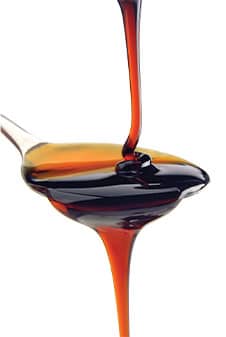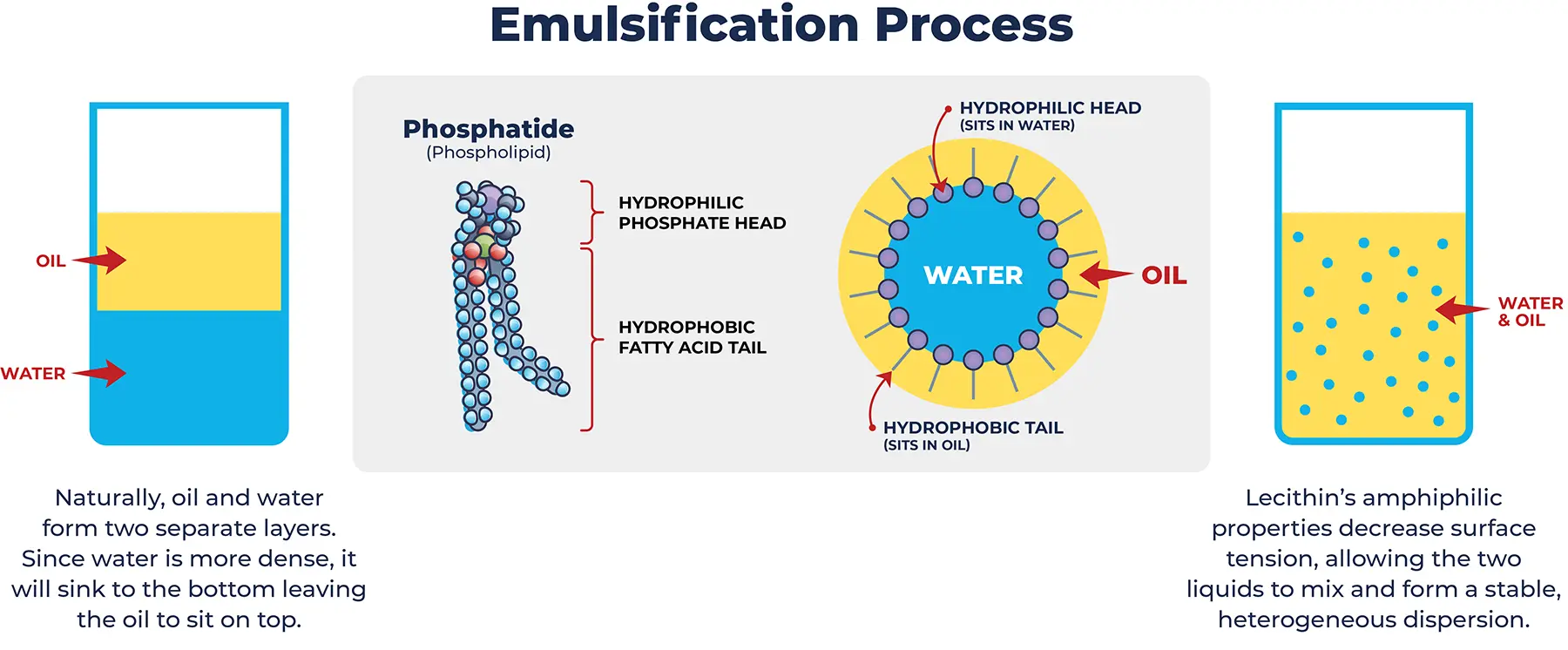Lecithin
Lecithin, derived from the Greek word “lékithos”, refers to a complex blend of essential fatty compounds—also known as phosphatides—obtained as by-product when extracted from various naturally occurring sources.
The phosphatides in lecithin, such as phosphatidylcholine (PC), have been widely acclaimed by nutritionists for their extensive range of heart, brain and liver health benefits.
Due to lecithin’s intricate composition and desirable surface-active functionality, the multi-purpose ingredient is widely used in commercial production processes for its emulsifying, dispersing, and stabilizing abilities.
The active components of lecithin (phosphatides) are both lipophilic and hydrophilic, prompting different affinities for oil and water dependent on form. Lecithin’s diverse amphiphilic characteristics make it the ideal natural multi-purpose food ingredient for a wide range of applications across various industries.
Available in both liquid and powder (deoiled) forms, Austrade Inc. currently offers lecithin from three plant-based sources: sunflower, rapeseed, and soy.
Applications
Bread + Baked Goods
- Easier dough handling
- May extend shelf-life
- Improves fat distribution
- Acts as a release agent for tortillas
Chocolate + Confectionery
- Shortens conching time
- Reduces fat bloom formation
- Less stickiness
Deli Meat + Cheese
- Acts as a release agent to stop slices from sticking to each other
Instant Products
- Improves dissolution of agglomerated powder into solution with minimal agitation
Dietary Supplements
- Improves stability and protection against oxidation
- Improves bioavailability
Beverages
- Facilitates the dispersion of fats
- Acts as a foam stabilizer
Sauces + Dressings
- Promotes even dispersion and enhances bonding of individual ingredients
- Improves consistency and mouthfeel
Plant-Based Products
- Supports foam stabilization
- Natural plant-based emulsifier
Austrade Lecithins
Sunflower
Nine food groups cause 90% of all known food-allergic reactions, which are summarized in the “Food Allergen Labeling & Consumer Protection Act of 2004”.
Sunflower lecithin has become the leading clean-label form of lecithin in recent years. Sunflowers are naturally GMO-free plants that have the remarkable ability to thrive in fluctuating temperatures, and in almost any kind of soil.
Sunflower lecithin is the perfect Non-GMO alternative to replace genetically modified soy lecithin.
The advantages of sunflower lecithin are vast—including a relatively neutral taste and very low odor, better dispersing and emulsifying properties due to its higher phosphatidylcholine (PC) content, and better stability due to its lower linolenic acid content.

The performance of sunflower lecithin is equivalent to that of soy lecithin, and its applications are identical. Available in Organic and Non-GMO liquid options as well as Non-GMO Deoiled powder, and specialty blends.
Rapeseed
Compared to other sources, Rapeseed lecithin contains a significant amount of C18:3 ALA (alpha-linolenic acid).
Demand for non-soy lecithin has grown exponentially in recent years due to global GMO issues in soybeans, and an increased effort to source allergen-free ingredients.
The rapeseed plant is a member of the Brassicaceae family and a cousin of well-known crucifers like cabbage and turnips. It produces bright, yellow flowers and contains tiny seeds from which the rapeseed oil is extracted.
Identical in functionality to soy lecithin, Rapeseed lecithin serves as an excellent Non-GMO alternative. Available in Non-GMO liquid and De-Oiled powder options.

Soy
The production of soy lecithin requires significantly less raw material than sunflower or rapeseed lecithin.

Liquid vs. Powder
Liquid
 Liquid lecithin aids in applications such as chocolate production due to its ability to adjust a fluid’s viscosity (“thickness”) by reducing the friction between solid particles once submerged in liquid.
Liquid lecithin aids in applications such as chocolate production due to its ability to adjust a fluid’s viscosity (“thickness”) by reducing the friction between solid particles once submerged in liquid.
Since it is already in liquid form, it does not need to be dissolved for application unlike powdered lecithin. Mixtures with high-fat contents are emulsified or stabilized by adding liquid lecithin. This form is used in the following ways:
- Confectionery and Edible Items: Combines fat content of chocolate/confectionery items, enhances stability, and prolongs shelf-life.
- Pharmaceutical Industry: For stabilizing creams, skin lotions, and ointments.
- Cosmetics: Acts as an antioxidant, dispersing agent for pigments, and locks moisture.
- Beverages: Facilitates the dispersion of fats, improving stability and viscosity. Modified lecithin available for water-based beverages.
Powder

Fully dissolving powdered lecithin is vital to avoiding clumps or unpleasant texture in the mixture.
Powdered lecithin is typically used in the following ways:
- Dietary Supplements: Improves stability and protection against oxidation.
- Food: Stabilizes bread formation and enhances the texture of multiple dressings, sauces, and chewing gums.
- Capsules and tablets: Works as a release agent for capsules and as a dispersing agent in tablets.
- Nut-Butters and Margarines: Reduces stickiness and provides even dispersion of ingredients.
